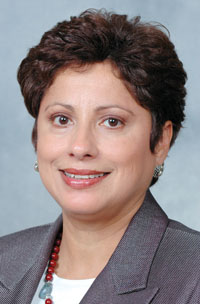
By Maria Neira
NYSUT Vice President
I've had a few weeks to reflect on my recent visit to Finland, and I'm struck by the many contrasts between this small Nordic nation and our own. As New York state and the nation grapple with reform agendas that devalue teachers and over-emphasize testing, Finland is taking a different path.
Now, after 30 years of commitment to its sustained educational strategy, Finland is consistently ranked number one in international measures of student achievement. For me, the essential question is this: What lessons can be drawn from Finland's experience to broaden the conversations in New York state about public education?
I traveled to Finland as a member of a delegation comprised of top-ranking policymakers for the U.S. Department of Education, other union leaders, higher education faculty and leaders of think tanks and education foundations. We witnessed Finland's successful departure from "conventional wisdom" and its commitment to a comprehensive long-term strategy that runs counter to prevailing reforms in the U.S.
The first thing we noticed? Everything Finland is NOT doing.
Thirty years ago, when the country fundamentally remade its education system, Finland said "no" to high stakes testing, tons of homework, market-style competition and developmentally inappropriate academic drills in early childhood. Pasi Sahlberg, director general at the Finnish Ministry of Education and Culture, told us Finland's educators are, in fact, firm in their opposition to the tenets of what he calls the "Global Education Reform Movement" — GERM.
We were inspired to hear how Finland moved from mediocrity to international achievement through a sane, comprehensive strategy that centers on teacher professionalism, early childhood education for all and equity in education.
Perhaps the most extraordinary feature of the Finnish educational revolution is the value and trust it places on teachers. Finland prioritizes the importance of teaching as a profession — not by paying it lip service, but by making a sustained investment in preparing and empowering teachers as professionals.
Finland pays for the education of its teachers, who are required to earn a master's degree that encompasses a full year of practice teaching at a Professional Learning School, fully supported with a stipend.
This high-quality, immersive preparation produces a corps of professionals whose country has invested in them and consequently empowers them as trusted professionals.
Imagine what it would be like to teach in a system where you are trusted to assess student progress and help design curriculum!
That trust means Finland's teacher unions are full partners in making educational decisions large and small.
Several members of the delegation asked a Finnish union leader: "What happens when there is a disagreement?"
He looked surprised. "It wouldn't happen, because we're all at the table from the beginning to the end," he said. "Our goal, and our result, is consensus."
What occurred in Chicago — teachers forced to strike because of top-down, educationally unsound directives — would be unthinkable in Finland, where 96 percent of teachers are unionized and fully empowered as equal professional partners.
Second, Finland provides quality early childhood programs for all children beginning at age 3. The programs are staffed by teachers holding bachelor's degrees and are designed around a deep understanding of child development that emphasizes play as a developmental necessity.
Refreshingly, we didn't see 3-year-olds being drilled on numbers or letters.
They were engaged in play and interaction with adults that provide the developmental foundation for academic growth. This comprehensive early childhood program is buttressed by a strong social services network, a focus on the whole child, and a sense of shared responsibility to ensure children are ready to learn.
Third, Finland has made equal opportunity for all the fundamental underpinning of its education system.
Unlike the U.S., where resources devoted to a child's education are dependent on geography and parental wealth, Finland's commitment is to give all students a quality public education based on high expectations for every child.
Repeatedly, we heard: "Education is a priority in this country. When it comes to making budget cuts, education isn't touched, regardless of what party's in power."
Equity is reflected not only by resources, but in Finland's commitment to small class sizes, early intervention and wrap-around services. Think about what our system would be like if we followed Finland's lead and made educational equity the driver for every decision we made!
One surprise for me was Finland's growing diversity. I had expected a homogeneous student body, yet visited a school where 35 percent of the students are immigrants. Since the 1990s, Finland has grown increasingly diverse and at a rate faster than any other country in Europe. Ten percent of the country is now non-Finnish speaking.
Of course, the tenets of Finland's progress — teacher professionalism, early childhood education and equity for all children — are not new. In our country, research has confirmed the value of these fundamental principles and NYSUT, along with the AFT and NEA, have espoused them for decades.
Yet it was inspiring to see in Finland proof that a sustained, sane, comprehensive strategy delivers results — a compelling contrast to "flavor of the month" reforms and so-called quick fixes.
For us to adopt a similar strategy would, without question, require a fundamental re-thinking of how we view public education, and a commitment to systemic, long-term change.
Finland's philosophy that "everyone owns the child" and has shared responsibility for ensuring all children are ready to learn is a powerful lesson we all can share as we move forward in New York state.